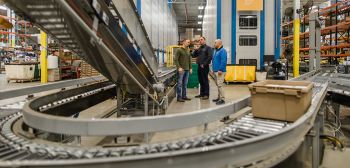Keeping Current: Things to Consider Before Your Next Plant Shutdown
- June 24, 2021
- Video
- Automation
Whether your next plant shutdown is planned to conduct maintenance or results from an unexpected circumstance (like COVID-19), there are proactive steps you can take to make start-up a success.
Ask yourself these four questions:
- Will you keep power and utilities on during the shutdown?
- How long is the shutdown intended to last?
- What is the state of repair for your equipment and processing lines at the time of the shutdown?
- Will engineering or maintenance staff be available at the time of shutdown?
When a plant shutdown is planned, it is advantageous to have engineering or maintenance staff on site. This eliminates the need to down equipment for extended periods of time, which decreases your risk for startup failures and the loss of memory in devices, especially your PLCs and drives.
Keeping power and utilities live to equipment can help protect your devices, retain program configurations you have built, protect the health of equipment, facilitate a faster startup, and more. It also allows you the opportunity to preform maintenance on process lines and equipment, as well as modernize your facility to improve readiness for future demands.
When a plant shutdown is unplanned or unexpected, and power and utilities are turned off, there are precautionary steps you can take to reduce startup failures.
Consider the following items as you plan for your next plant shutdown and restart.
- Backup intelligent devices before shutting down. Intelligent devices like drives, softstarts, PLCs, operator interfaces, ethernet switches, overloads and sensors should have a current “backup” of configuration setting. Before shutting down, make sure that the backup settings are initiated to ensure the ability to restore operation in the event of failure on start-up. Failure to do so, may cause loss of programming and valuable time to reconfigure programs. This simple step will save you time and money while avoiding a potential failed start-up. While you are backing up your devices, be sure to check batteries (if installed).
- Take inventory of spare parts. Older or obsolete parts may not start back up after a shutdown. Make sure you take inventory of your storeroom and all the parts you might need. Once you take inventory, reach out to your Van Meter Automation Product Managers. They can review the list and let you know what is obsolete or still available. If a part is obsolete, they can work with you to find the best alternative or upgrade to meet your need and get you up and running quickly.
- Complete a thorough maintenance cleaning of all equipment and process lines. During a shutdown, things can clog and settle in your devices when they are not in motion, which can cause a start-up failure. By flushing and refilling gearboxes, equipment, and cooling systems, as well as lubricating equipment, you’ll reduce mechanical sticking and freezing due to grime build up or corrosion that can happen during a shutdown.
- Prepare equipment for environmental factors. If you have equipment that is temperature sensitive, make sure you have proper heating or cooling available to those devices. Some devices cannot go below or above certain temperatures or they’ll fail at start-up. If you are not sure if they are impacted, check out the OEM Operator Manual online via Rockwell Automation Knowledgebase, or reach out to your Van Meter Automation Product Managers.
- Stow machines in a “home position” or “setup/ready” before powering down. It is beneficial to have it at this state instead of a mid-stride or hap-hazard position.
- Document everything. To make things easier in the future, be sure to record all process settings, maintenance schedules, sequence of operations and operations manuals. Make sure documentation is located and easily accessible to reference for future shutdowns/start-ups.
- Start-up with no loads. When it is time to start everything back up, be sure to do so with no loads and allow your electrical devices to stabilize. Once everything is stabilized, start-up at reduced speeds to evaluate everything is working well before you start running product. This will allow you to monitor how things are going and make any necessary changes to reduce downtime once products start running on the lines.
Always remember that you are not in this alone. If you have a planned or unexpected shut down, contact your Van Meter Automation Product Managers to answer any questions you have, and get the necessary equipment and resources to make your shut down and eventually your start up successful.
